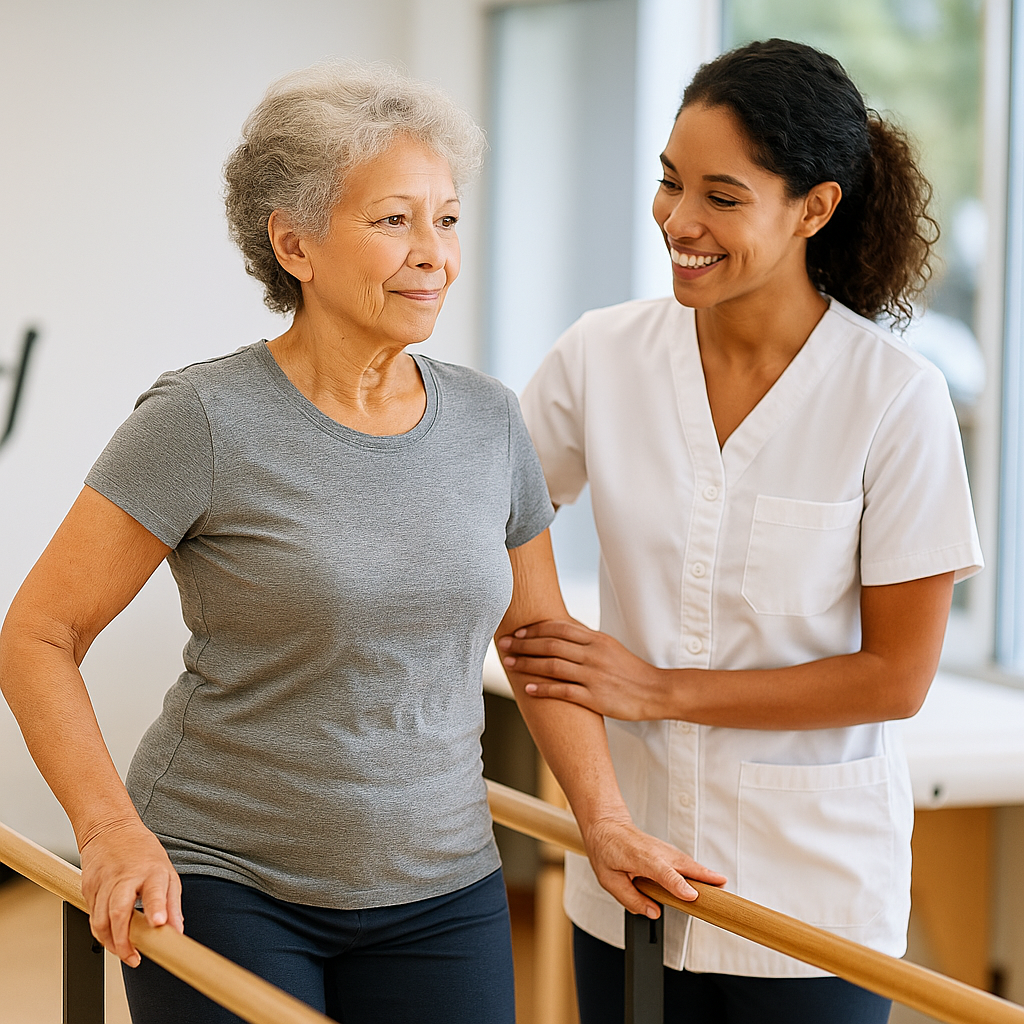There’s a moment many people reach — a near fall, a shaky step, or that quiet feeling of, “I don’t move like I used to.” It can be unsettling, but it’s also the perfect time to take action.
That’s where physical therapy shines. It’s not just for recovering after injury — it’s about rebuilding confidence, mobility, and independence through guided, safe movement. For seniors and caregivers alike, physical therapy is often the missing bridge between wanting to stay active and knowing how to do it safely.
Understanding What Physical Therapy Really Does
At its heart, physical therapy (PT) is about helping your body work for you again — not against you.
Therapists don’t just show you exercises; they help retrain your muscles, improve your balance, and teach your body to move efficiently.
They look at how you sit, stand, reach, and walk — and create a plan that meets you right where you are.
That plan might include gentle stretching, strengthening, and balance drills that improve your stability without overworking your joints.
🧠 Think of PT as movement medicine — personalized, safe, and built around your body’s unique needs.
Why Strength and Balance Training Matters for Seniors
Strength and balance go hand in hand. Muscles provide stability; balance keeps you upright; confidence ties them together. As we age, we naturally lose some muscle mass and flexibility, which can make simple tasks — climbing stairs, carrying groceries, or stepping off a curb — feel uncertain.
But the good news is that your body can rebuild strength at any age. Studies show that seniors who participate in guided exercise programs — especially those created by physical therapists — experience fewer falls, less joint pain, and better mobility within weeks.
What to Expect from a Physical Therapy Session
If you’ve never been to PT before, it’s normal to wonder what happens during a session. Here’s what most people experience:
- Evaluation:
Your therapist will check your strength, balance, flexibility, and walking pattern (called your gait).
They’ll ask about pain, fatigue, and your goals — whether it’s getting around your house safely or walking through the park again. - Personalized Exercises:
You’ll learn movements that target your needs — leg lifts for strength, heel-to-toe walking for balance, gentle stretching for flexibility, and more. - Guided Practice:
Your therapist will correct your posture and show you how to move safely. They may also recommend small changes at home — like different shoes or furniture placement — to support your progress. - Home Plan:
You’ll receive simple exercises to practice between visits. Consistency is key — just a few minutes daily can make a life-changing difference.
🩺 Every exercise is designed for safety and gradual improvement. There’s no rushing, no pressure, and no competition.
Common Techniques That Help Improve Strength and Balance
Here are some of the most common and effective physical therapy techniques used for older adults:
- Gait Training: Improves walking speed, step length, and posture.
- Strengthening Exercises: Focuses on legs, hips, and core — muscles most responsible for balance.
- Balance Drills: Practice standing on one foot or shifting weight safely from side to side.
- Functional Training: Recreates everyday movements, such as standing from a chair or reaching overhead.
- Flexibility Work: Keeps joints moving smoothly to reduce stiffness.
- Assistive Device Training: Teaches proper use of canes, walkers, or rollators for stability.
Each exercise is tailored to your ability level. No two plans are the same — and that’s the beauty of it.
For Caregivers: How You Can Help
If you’re caring for someone going through therapy, your encouragement is powerful.
Here’s how you can make the journey smoother:
- Create a safe space at home to practice exercises — clear, quiet, and well-lit.
- Join in when you can. Doing a few stretches together can turn therapy into bonding time.
- Track progress. Small wins add up, and celebrating them keeps motivation high.
- Ask questions. Physical therapists love when caregivers get involved — it helps everyone stay consistent.
❤️ Support and patience from a loved one often make the biggest difference.
When to Talk to a Doctor or Therapist
Not every ache means you need therapy, but certain signs should prompt a conversation:
- Frequent stumbles or loss of balance
- Muscle weakness or “wobbly” legs
- Trouble getting up from chairs or the bed
- Ongoing back, hip, or knee pain
- Fear of falling or avoiding activity altogether
You can ask your doctor for a physical therapy referral — or many clinics accept self-referrals depending on your insurance.
Medicare Part B and most insurance plans cover therapy for balance, strength, or fall prevention if prescribed by a provider.
Real-World Success: It’s Never Too Late
Many people think therapy is for athletes or post-surgery recovery, but that couldn’t be further from the truth.
Seniors in their 70s, 80s, and even 90s often experience dramatic improvements after a few weeks of consistent sessions.
They walk more confidently. They climb stairs again. They feel in control.
And most importantly — they rediscover the freedom of movement they thought they’d lost.
🌿 Physical therapy doesn’t just strengthen your body. It restores your independence and peace of mind.
A Few Simple At-Home Exercises to Start (With Approval)
Even before starting formal therapy, there are safe movements most seniors can try at home — always with a sturdy chair or counter nearby for support:
- Seated Marches: Strengthens hip flexors and improves circulation.
- Heel Raises: Builds ankle and calf strength for better walking control.
- Sit-to-Stand Repeats: Improves leg power and confidence for daily movement.
- Side Steps: Enhances balance and lateral stability.
Always move slowly and stop if you feel pain or dizziness.
If you’re unsure where to begin, your physical therapist can show you the safest approach for your condition.
Final Thoughts
Physical therapy isn’t just about exercise — it’s about reclaiming confidence in your own body.
Each session builds a little more stability, a little more strength, and a lot more independence.
For seniors, that means more time enjoying the moments that matter — walking to the garden, standing in the kitchen without fear, or simply moving without hesitation.
For caregivers, it means peace of mind, knowing your loved one is safe, capable, and supported.
🩵 Strong muscles. Steady steps. A confident life — it all starts with movement.
Recommended Reading:
- Balance and Exercises: Gentle routines to strengthen legs and coordination.
- Mobility Aid Choices: Find the best support tools for safe movement.
- Safe Movement at Home: How to make your space balance-friendly.
💬 Frequently Asked Questions
1. Is physical therapy only for people recovering from injury?
Not at all. Many seniors use physical therapy simply to improve balance, strength, and flexibility. It’s about staying active, preventing falls, and maintaining independence — not just recovery.
2. How often should seniors go to physical therapy?
It depends on your goals and condition. Most people start with 1–2 sessions per week, then continue at home using the exercises their therapist recommends. Consistency matters more than frequency.
3. Does Medicare cover physical therapy for balance problems?
Yes. Medicare Part B usually covers medically necessary physical therapy if prescribed by your doctor. That includes sessions for fall prevention, muscle weakness, or mobility challenges.
4. What can I do between sessions to keep improving?
Follow your therapist’s home plan. Gentle activities such as seated marches, heel raises, or short daily walks can help you progress safely and build confidence.
5. Can physical therapy really make a difference at my age?
Absolutely. Strength and balance can improve at any age. Many older adults notice steadier movement, better posture, and less joint pain after just a few weeks of guided therapy.
6. How can caregivers help during physical therapy?
Encourage practice, ensure a safe space for exercises, and celebrate progress. Your support helps the person stay motivated — and helps you both feel more confident about daily movement.





